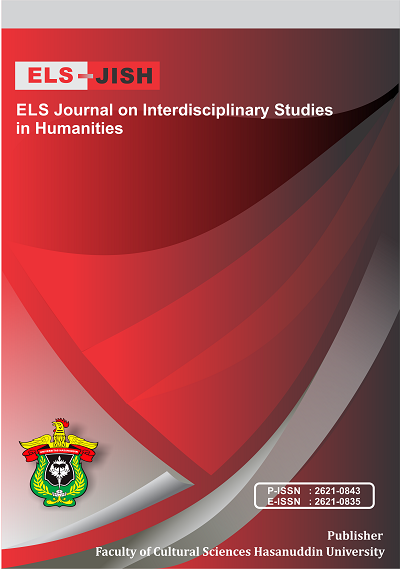A Socio-Pragmatic Analysis of Social Media Comments on Online Learning at the Time of COVID 19
DOI:
https://doi.org/10.34050/elsjish.v3i4.11525Keywords:
socio-pragmatic analysis, online learning, Covid19, social media comments, Strategies and maximsAbstract
The fundamental aim of the present study is to analyze the pragmatic aspects of the English social media comments on posts related to online learning at the time of Covid19. The aim in this socio-pragmatic study is to identify the maxims and strategies used by English commenters and the extent to which the commenters follow or flout these and strategies when commenting on posts related to online learning at time of COVID 19. It also aims at investigating how the social media, as a new marvelous vital trend, contributes to increase language and linguistic variation in people's online comments. To achieve these the researchers analyze 25 Facebook comments based on two adopted models; Grice's (1975) maxims and Crystal's strategies (2001) to build a comprehensive picture about the role of age, gender, social status on the comments. The results of the analysis show that both models are applicable and sometimes flouted. Some commenters flout more than two maxims in the same comment and the same is true regarding Crystal's model. It has been found that comments are highly constrained by social factor, while age and gender do not have great significant effect.
References
Al-Obaydi, Liqaa and Ibrahim, Atyaf (2019) The Effect of Viber Application on the Acquisition of Clipped, Blended and Acronym Words. The Online Journal of Quality in Higher Education - January 2019Volume 6, Issue 1.
Andresen, N. (2013) Flouting the Maxims in Comedy: An Analysis of Flouting in the Comedy Series Community. Master Thesis. Department of Language, Literature and Intercultural Studies.
Anderson,T. (2008) The Theory and Practice of Online Learning. Athabasca University. 2nd edition. AU press
Baron, N. (2001) Language Of The Internet In Stanford Handbook For Language Engineers. Ali Farghali(Ed) Stanford California: CSLI Publications,1-63. Center for the Study of Language and Information.
Baten , L. Stijn V and Bert De. C. (2009) Learning: a Pragmatic Framework for 2nd Generation E-Learning Projects. Information and Communications Technologies (ICT 2009).RePEc
Crystal, D. (2001).Language and the Internet. New York. Cambridge University press.
Faisal, A. Samir, M. Iqbal, S.M. and Yasin, M. (1999) Effectiveness Of Cyber Learning. Karachi, Pakistan. 9th ASEE/ IEEEF rotifers in (Education Conference13a28) .Institute of electrical and electronic engineers.
Grice, H.(1975) Logic and Conversation. In Cole, p. and Morgan, J. L. (Eds). Speech Acts. New York: Academic press.
Jovanovic, D. (2013) A Qualitative Study of the Use of Net Speaks in English Language Classroom. (Master thesis).
Kollock, P. and Smith, M. (1999) Communities in Cyberspace. London: Rutledge
Leech, G. (1983) Principles of Pragmatics. London: Longman
Logan, R. (2004) The Sixth Language: Learning a Living in the Internet Age. University of Toronto. Toronto press.
Malhotra,S. & Goyal,A.(2013) Role of Online Education in Modern Education System. E-Vaani: An International Journal of Research in Management & IT. Volume: 1, NO: 1. ISSN No. 2348 1536.6.195.
Martinich, A. P. (1980) Conversational Maxims and Some Philosophical Problems. The Philosophical Quarterly (1950).Vol. 30, No. 120 , pp. 215-228 . Oxford University Press
Olaniran ,S.(2014) Social Media And Changing Communication Patterns Among Students. Covenant Journal of Communication (Cjoc), Vol. 2, No. 1. university Of Jos, Nigeria
Othman, M. , Mohamad, N., Yusuf, L., Yusof, N., and Suhaimi, S. (2012) An Analysis of e-Learning System Features in Supporting the True e-Learning. 2.0. Procedia - Elsevier Ltd. Social and Behavioral Sciences 56, 454 – 460.
Partey, F. ,Rosemary, G.Addo-Danquah, Lucy, K.B. and Kwasi S.(2018) Investigating Unconventional Abbreviations In sms Texts. International Journal of Applied Linguistics & English literature E-ISSN: 2200-3452 & P-ISSN: 22003592.IJALEL.
Pozgaj, Z. and knezevic, B. (2007) E-Learning: Survey on Students' Opinions. 10.1109/ITI.2007.4283800.Conference: Information Technology Interfaces, 2007. ITI 2007. 29th International Conference.
Prensky,M.(2001) Digital Native .Digital Immigrants .On the Horizon,9(5),1-6
Surian, L. Simon B.C. and Heather V. der L. (1996)."Are Children with Austin Deaf to Gricean Maxims?" Cognitive neuropsychiatry. Psychology Press (UK): Taylor & Francis Ltd. Vol. 1, No. 1,1996: P.P.55-71.
Surjono, H.D. Ali, M. and Wahyuningsih, D .(2017). The Implementation of Blended Learning in Multimedia Courses for Undergraduate Students in Indonesia. International Journal of Information and Education Technology, Vol. 7, No. 10, October 2017
Varnhagen, Connie K., McFall, G. Peggy and Pugh, Nicole, Routledge, Lisa; Sumida MacDonald, Heather and Kwong, Trudy E. (2010) lol: New Language and Spelling in Instant Messaging. An Interdisciplinary Journal, v23 n6 p719-733 Jul 2010 Connie. Routledge, Lisa. ERIC.
Downloads
Published
Issue
Section
License

This work is licensed under a Creative Commons Attribution-NonCommercial 4.0 International License.






